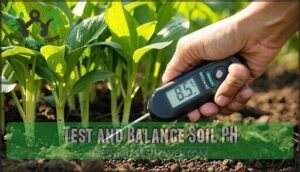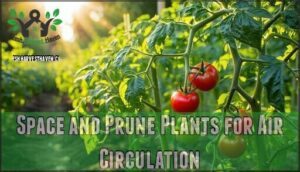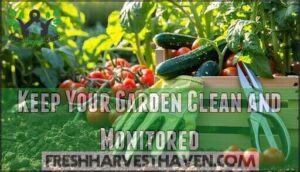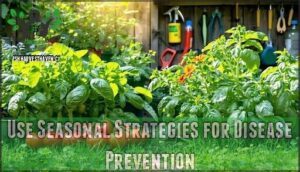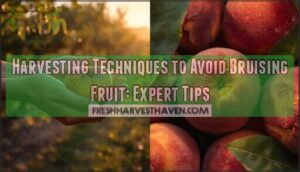This site is supported by our readers. We may earn a commission, at no cost to you, if you purchase through links.
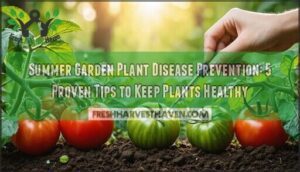 Your summer garden plant disease prevention starts with choosing resistant varieties like ‘Crimson Crush’ tomatoes that naturally fight off pathogens.
Your summer garden plant disease prevention starts with choosing resistant varieties like ‘Crimson Crush’ tomatoes that naturally fight off pathogens.
You’ll want to maintain soil pH between 6.0-7.0 using a soil meter, then add organic matter to boost beneficial microorganisms that outcompete diseases.
Water at soil level with soaker hoses instead of overhead sprinklers to keep foliage dry, and always do this in early morning so excess moisture evaporates quickly.
Remove diseased debris immediately and disinfect your tools with bleach solution between plants to prevent cross-contamination.
These foundational strategies create an environment where your plants thrive while pathogens struggle to establish themselves.
Table Of Contents
- Key Takeaways
- Choose Disease-Resistant Plants and Varieties
- Maintain Healthy Soil and Roots
- Practice Smart Watering and Airflow Techniques
- Keep Your Garden Clean and Monitored
- Use Seasonal Strategies for Disease Prevention
- Frequently Asked Questions (FAQs)
- How to prevent the spread of diseases in plants?
- How to prevent garden diseases?
- What are the 5 principles of plant disease control?
- How do I know if my plant has a bacterial or fungal infection?
- How do companion plants help prevent diseases?
- When should fungicides be applied for effectiveness?
- What tools require disinfection between different plants?
- How does mulching prevent soil-borne disease spread?
- Which watering schedule minimizes fungal disease risk?
- What natural fungicides work best in summer?
- Conclusion
Key Takeaways
- You’ll prevent most diseases by choosing resistant plant varieties like ‘Crimson Crush’ tomatoes and ‘Knockout’ roses that naturally fight off pathogens without needing constant chemical treatments.
- Maintain soil pH between 6.0-7.0 and add organic matter to boost beneficial microorganisms that outcompete harmful diseases while creating stronger plant foundations.
- Water at soil level using soaker hoses in early morning to keep foliage dry and prevent the humid conditions that fungal and bacterial diseases love.
- Remove diseased debris immediately and disinfect tools with bleach solution between plants to stop cross-contamination before it spreads throughout your garden.
Choose Disease-Resistant Plants and Varieties
You’ll save yourself countless hours of battling diseases by selecting plants that naturally resist common summer pathogens. Smart gardeners know that disease-resistant varieties act like built-in insurance policies, reducing your need for chemical treatments while keeping your harvest abundant.
Select Suitable Plant Species for Your Region
The right plant in the right place is your first defense against plant diseases. Climate-adapted species thrive naturally in your region’s conditions, requiring less intervention and showing better disease resistance than struggling imports.
- Visit local nurseries for regional plant selection guidance and native plant benefits
- Match plants to your soil type through testing and professional recommendations
- Choose climate-adapted species that handle your area’s temperature and humidity patterns
This foundation approach reduces host plant vulnerability before diseases even appear.
Identify and Use Disease-Resistant Cultivars
Why settle for vulnerable plants when disease-resistant varieties exist? Smart cultivar selection strengthens your host plant’s natural defenses against common pathogens.
Choose hybrids like ‘Crimson Crush’ tomatoes or ‘Knockout’ roses that pack genetic resistance into their DNA. Consider varieties like ‘Sarpo Mira’ potatoes for excellent blight resistance. Local nurseries often stock regional favorites proven to thrive despite disease pressure.
This hybrid vigor approach cuts fungicide needs while boosting yields—your garden’s insurance policy against summer’s disease challenges.
Match Plants to Site Conditions
Think of site selection as matchmaking for your garden. You’re setting up plants for success by understanding their needs first. Check your hardiness zones, then assess soil type and sun exposure patterns throughout your yard.
Study microclimates—those sunny corners or damp spots that create unique conditions. Water availability matters too. When you match plants to their ideal site conditions, you’re already winning the battle against plant diseases through smart prevention and proper planting guidelines.
Maintain Healthy Soil and Roots
Your garden’s foundation matters more than you might think, since healthy soil creates the strongest defense against summer diseases. When you maintain proper soil pH, add organic matter regularly, guarantee good drainage, and control harmful nematodes, you’re building an underground fortress that keeps pathogens from gaining a foothold in your plants’ root systems.
Test and Balance Soil PH
Before planting anything, you’ll want to test your soil’s pH since it directly affects nutrient availability and plant health. Well-balanced soil creates the foundation for disease prevention by supporting strong, resilient plants that can naturally resist infections. You can use a soil acidity meter to measure pH levels.
- Use a digital pH meter or test strips for accurate readings
- Target pH between 6.0-7.0 for most vegetables and flowers
- Add lime to raise pH or sulfur to lower it gradually
- Retest after amending soil to confirm proper levels
Add Organic Matter and Mulches
Organic matter transforms your soil into a disease-fighting powerhouse. Compost, aged manure, and leaf mold boost beneficial microorganisms that outcompete harmful pathogens. Apply a 2-3 inch layer of organic mulch around plants for moisture retention and temperature regulation. Many gardeners find that mulch improves soil.
| Mulch Types | Benefits |
|---|---|
| Shredded bark | Long-lasting weed suppression |
| Compost | Soil enrichment and plant health |
| Straw | Excellent moisture retention |
Improve Drainage and Prevent Root Rot
Poor drainage creates waterlogged conditions that suffocate roots and invite root rot disease. Combat soil compaction through aeration techniques like core aerification or adding coarse organic matter.
Install drainage solutions such as French drains or switch to raised beds for better control. Container gardening offers excellent drainage management.
Monitor soil moisture regularly—proper watering means moist, not soggy conditions. Overwatering often leads to oxygen-starved soil.
Control Root Knot Nematodes
Nobody wants these microscopic plant parasites wreaking havoc in their garden. Root knot nematodes disrupt the nematode life cycle through strategic nematode control methods.
Try soil solarization during hot summers, rotating crops with non-host plants, and adding biological controls like beneficial fungi. Choose resistant rootstocks when possible. A good strategy is to look for the "N" symbol on seed packets.
These nematode management techniques tackle soilborne problems before they destroy your harvest.
Practice Smart Watering and Airflow Techniques
Smart watering and proper airflow work together as your garden’s immune system, preventing the warm, humid conditions that pathogens love. You’ll dramatically reduce disease pressure by watering at soil level and ensuring adequate spacing between plants, since most fungal and bacterial infections thrive when moisture lingers on leaves and air circulation remains poor.
Water at The Base, Not Overhead
Overhead watering creates a dangerous cycle where foliage moisture encourages fungal diseases in high humidity. Proper watering at plant bases ensures efficient watering while promoting disease prevention through root hydration without wet leaves.
- Direct water to soil level – keeps leaves dry and reduces disease spread
- Use soaker hoses or drip irrigation – delivers water conservation with precision
- Water early morning – allows any splashed moisture to evaporate quickly
- Avoid sprinkler systems – they’re like throwing a disease party for your plants
- Check soil moisture first – prevents overwatering that weakens plant immunity
Space and Prune Plants for Air Circulation
Proper spacing and strategic pruning techniques create the airflow improvement your plants desperately need. Disease reduction happens when you prune the plant for airflow, removing overcrowded branches that trap moisture. Summer garden diseases thrive in stagnant air, but proper spacing between plants allows wind to naturally dry foliage. Plant vigor increases dramatically when air circulates freely around stems and leaves, preventing the humid microclimates that pathogens love.
| Spacing Benefits | Disease Prevention Impact |
|---|---|
| Air circulation | Reduces fungal spore settling |
| Faster leaf drying | Prevents bacterial growth |
| Light penetration | Strengthens plant immunity |
| Reduced humidity | Blocks pathogen development |
| Better monitoring | Allows early detection |
Avoid Overwatering in Humid Conditions
In summer’s sweltering embrace, humidity management becomes your garden’s lifeline. When high humidity meets overwatering, you’ve created a fungal paradise.
Check soil moisture before watering—if it’s damp an inch down, skip it. Deep, infrequent watering promotes root health while preventing waterlogged conditions. Consider using mulch to help retain moisture, as organic types offer benefits.
Proper watering at soil level, combined with proper airflow, reduces disease prevention headaches substantially.
Keep Your Garden Clean and Monitored
Maintaining a clean garden environment and regularly checking your plants creates the foundation for effective disease prevention throughout the summer growing season.
You’ll catch problems early when they’re easiest to manage, while removing potential breeding grounds for pathogens that can devastate your harvest.
Remove Diseased Debris and Weeds
Clearing diseased plant material and weeds acts as your first defense in inoculum reduction for plant health. Remove fallen leaves, dead stems, and infected debris immediately to prevent pathogens from overwintering.
Weeds serve as vectors for disease transmission, harboring viruses and bacteria. Garden sanitation practices eliminate hiding spots where problems multiply.
These weed control methods support thorough disease prevention through proper garden hygiene.
Disinfect Tools and Containers
Dirty tools act like disease carriers, spreading pathogens between sick plants and healthy ones throughout your garden.
To prevent this, use a bleach solution ratio of 1:9 (one part bleach to nine parts water) for effective container sterilization. Allow a thirty-minute disinfectant contact time to kill bacteria, fungi, and viruses.
This simple garden sanitation practice prevents cross-contamination between plants. Consider exploring different product purchasing options for your needs.
Regularly Inspect for Early Disease Signs
Weekly walkthroughs catch problems before they spread throughout your garden. Look for yellow spots, wilting leaves, or fuzzy growth on plant surfaces—these signal early disease development.
Record findings in a simple log to track patterns and identify which plants need attention. **Early detection prevents costly crop losses and reduces chemical treatments needed later.
**
**Maintaining proper garden sanitation helps eliminate disease sources.
Use Seasonal Strategies for Disease Prevention
You’ll achieve the best disease prevention results when you align your garden practices with each season’s unique challenges and opportunities. Timing your interventions correctly transforms reactive treatments into proactive strategies that keep pathogens from establishing themselves in your garden ecosystem.
Prepare Soil and Beds in Spring
Three key spring soil prep steps set your garden up for disease prevention success. Add compost or aged manure to boost microbial activity and organic matter, and spread 2 to 3 inches of compost and mix it into the top 6 to 8 inches of soil. Proper soil amendment timing creates healthy foundations that naturally resist fungal and bacterial threats throughout the growing season.
Spring is also the time for clearing winter debris from garden beds.
Monitor for Fungal and Bacterial Issues in Summer
Summer brings peak conditions for fungal diseases and bacterial spread factors that can devastate your garden. Early disease detection becomes your best defense—inspect plants weekly for white powdery patches, water-soaked spots, or yellowing leaves.
Humidity’s impact creates perfect breeding grounds, while insect vector control helps prevent bacteria transmission. Watch for symptoms on lower leaves first, as most summer garden diseases start there before spreading upward through stressed plants.
Clean Up Thoroughly in Fall
After monitoring your plants through summer, fall cleanup becomes your strongest weapon against overwintering pathogens. Disease prevention starts with thorough debris removal—those fallen leaves harbor fungal diseases and bacterial diseases for next season.
Here’s your fall action plan:
- Remove all diseased plant material and destroy it (never compost infected debris)
- Practice proper composting practices with healthy material only
- Sanitize tools with bleach solution to prevent spreading plant pathogens
This systematic approach eliminates soilborne diseases before they can establish winter strongholds.
Protect Soil Health Over Winter
While your garden sleeps, winter soil cover becomes your secret weapon against spring diseases. Apply mulch or plant cover crops to reduce soil compaction and improve soil structure.
These practices encourage beneficial microbes, prevent nutrient loss, and maintain soil organic matter levels. Strategic crop rotation planning and nematode management during dormancy sets the foundation for healthier soil health come growing season.
Frequently Asked Questions (FAQs)
How to prevent the spread of diseases in plants?
Studies show 80% of plant diseases stem from environmental factors you can control. Break the disease triangle by removing pathogens, improving air circulation, and watering at soil level—not leaves.
How to prevent garden diseases?
You’ll prevent most garden diseases by choosing resistant varieties, spacing plants properly, watering at soil level, and removing infected leaves immediately when spotted.
What are the 5 principles of plant disease control?
You’ll succeed by mastering exclusion, resistance, protection, therapy, and eradication. Remove susceptible hosts, choose resistant varieties, create barriers against pathogens, apply treatments when needed, and eliminate disease sources completely.
How do I know if my plant has a bacterial or fungal infection?
Look for telltale signs: bacterial infections create water-soaked spots with yellow halos, while fungal infections produce fuzzy growth, powdery coatings, or distinct circular spots with defined borders.
How do companion plants help prevent diseases?
Companion plants create natural barriers that confuse pests and pathogens. You’ll find they release compounds that repel harmful insects while attracting beneficial predators. This teamwork reduces disease pressure naturally.
When should fungicides be applied for effectiveness?
Apply fungicides early morning when dew’s present but before temperatures rise. You’ll get better leaf coverage and absorption. Reapply every 7-14 days during humid conditions for maximum protection.
What tools require disinfection between different plants?
Like a surgeon’s scalpel carrying infection between patients, your pruning shears, knives, and loppers need disinfecting between plants.
Clean them with a 10% bleach solution to prevent spreading pathogens from diseased to healthy plants.
How does mulching prevent soil-borne disease spread?
Mulching creates a barrier between soil and plant leaves, preventing splashing that carries pathogens upward during watering or rain.
You’ll block spores from reaching vulnerable foliage while maintaining consistent soil moisture.
Which watering schedule minimizes fungal disease risk?
Like an old-timey telegram operator sending urgent messages, you’ll want to water early morning (6-8 AM) when temperatures are cool. This timing lets plants absorb moisture before heat hits, while leaves dry quickly, preventing fungal spores from taking hold.
What natural fungicides work best in summer?
Copper-based fungicides excel in summer heat, tackling downy mildew and bacterial spot effectively. Biofungicides with beneficial bacteria work well, while neem oil needs careful timing to avoid leaf burn.
Conclusion
Disease prevention might seem like gardening rocket science, but you’ve now got five straightforward strategies that actually work.
Your summer garden plant disease prevention success depends on consistent application of resistant varieties, healthy soil, smart watering, cleanliness, and seasonal awareness.
These aren’t complicated theories—they’re field-tested methods that turn your garden into a fortress against pathogens while you enjoy healthier plants and bigger harvests.
- https://www.thrivelot.com/resources/5-crop-rotation-tips-to-prevent-plant-diseases
- https://exclusives.ca.uky.edu/2024/hort/effective-strategies-prevent-plant-diseases-your-garden
- https://fieldreport.caes.uga.edu/publications/C862/disease-management-in-the-home-vegetable-garden/
- https://extension.okstate.edu/fact-sheets/non-chemical-methods-for-controlling-diseases-in-the-home-landscape-and-garden.html
- https://henderson.ces.ncsu.edu/2025/07/organic-and-biorational-pest-control-options/

